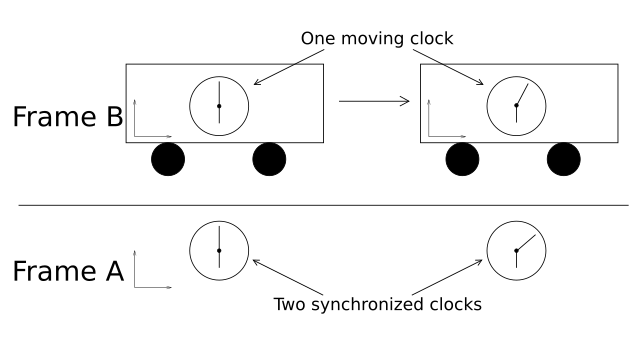
Caption: An illustration of time dilation (more precisely, special relativistic time dilation) and the asymmetry in time dilation between the situation with the two clocks in Frame A (which is an inertial frame) and the one clock in Frame B (which is another inertial frame). Frame A and Frame B are NOT accelerated with respect to each other.
Features:
- Special relativity tells us that
time flows at different rates
in different
inertial frames.
And remember any
reference frame is
a (true) inertial frame
(i.e., a free-fall frame
NOT rotating
with respect to the
observable universe)
or can be considered an
effective inertial frame
with the use of inertial forces.
By "time flows at different rates", we mean as measured by all clocks---mechanical clocks, atomic clocks, biological clocks---all clocks. To time itself flows at different rates.
The effect is called time dilation and it is probably the most mind-blowing feature of special relativity.
- Time dilation
is mnemonicked by saying
"Moving clocks run slow."
- In the image, the one Frame B clock
runs slow compared to the two Frame A clocks
which are at rest with
respect to each other in Frame A and are
synchronized.
A Frame A observer and a Frame B observer both agree on this.
But they also agree to observe the effect that there must be two clocks in Frame A at different places in Frame A and one clock in Frame B.
This is the asymmetry between the two observers that allows an asymmetric effect. Otherwise one might wonder why don't both observers see the other's clock as running slow which is symmetrical but impossible.
Without mathematical detail, it is hard to explicate how the asymmetry in number of clocks leads to asymmetry in time measurements. However, one can say that it an aspect of the connection between space and time in special relativity. The relativity speak term spacetime emphasizes the connection.
But note despite the connection, the space and time dimensions are distinct.
- Note if there were one clock in Frame A
and two clocks in Frame B,
then the Frame A clock would run slow
according to observers in both frames.
- Why do we NOT notice time dilation
in everyday life?
The time dilation and effects of relative velocity increase from zero as relative velocity increases between objects or inertial frames
The relative velocities in everyday life are too small to notice these effects of relative velocity without super accurate/precise measurements.
- Now what if Frame A and Frame B are
acceleration with respect to each other?
In this case, there is another kind of asymmetry, since special relativity does NOT treat all aspects of motion as relative.
Acceleration (relative to an inertial frame) is distinct from constant velocity (relative to an inertial frame).
The most famous aspect of time dilation with accelerated motion is the twin paradox explicated in Relativity file: time_dilation_twin_paradox.html. More explication of time dilation with accelerated motion is given in Relativity file: time_dilation_animation.html.
Image link: Wikimedia Commons: File:Time dilation explanation.svg.
Local file: local link: time_dilation_moving_clocks.html.
File: Relativity file: time_dilation_moving_clocks.html.